Table of Contents
Many entrepreneurs, creators, and small business owners find themselves overwhelmed by the seemingly complex process of trademarking a name. The fear of making a costly mistake or facing legal challenges can be paralyzing. But what if you could navigate the trademark process with confidence, armed with a step-by-step guide and practical tips?
In this comprehensive DIY guide, we’ll demystify the trademark process, break it down into manageable steps, and equip you with the knowledge and resources you need to secure your brand’s future. Whether you’re just starting out or ready to take your business to the next level, this guide will empower you to protect your most valuable asset—your name.
Understanding Trademarks: The Foundation
What is a Trademark?
In the simplest terms, a trademark is a word, phrase, symbol, design, or combination of these elements that identifies and distinguishes the source of goods or services. It’s like a unique fingerprint for your brand, setting you apart from competitors in the marketplace.
Think of the Nike “swoosh” logo, the Apple bitten apple symbol, or the phrase “Just Do It.” These are all trademarks that instantly conjure up images of their respective brands in our minds. Trademarks aren’t limited to logos; they can be any distinctive identifier associated with your products or services.
There are several types of trademarks:
- Word marks: Words, phrases, slogans (e.g., Coca-Cola, Kleenex, “I’m Lovin’ It”)
- Design marks: Logos, symbols, graphics (e.g., the Nike swoosh, the Target bullseye)
- Service marks: Marks used for services rather than products (e.g., FedEx, Xfinity)
- Collective marks: Used by organizations to indicate membership (e.g., Realtor)
- Certification marks: Used to certify goods or services meet certain standards (e.g., Good Housekeeping Seal)
Why Trademark? The Benefits for Your Business
Now that we’ve clarified what a trademark is let’s explore why it’s crucial for your business. Trademark registration offers several key benefits:
- Brand Protection: A registered trademark gives you exclusive rights to use the mark in connection with your goods/services. This prevents others from using confusingly similar marks that could dilute your brand or deceive consumers.
- Legal Recourse: If someone infringes on your trademark, registration provides a legal basis for taking action. You can sue for damages, obtain injunctions, and even have counterfeit goods seized.
- Marketing Advantage: A registered trademark is a powerful marketing tool. It signals to consumers that your brand is legitimate and trustworthy. It also makes it easier for customers to find your products or services online.
- Asset Value: A trademark is a valuable intangible asset that can be licensed, sold, or used as collateral for loans.
Trademarks vs. Other Intellectual Property
While trademarks protect brand names and logos, it’s important to distinguish them from other types of intellectual property:
- Copyrights: Protect original creative works like books, music, art, and software.
- Patents: Protect inventions and new processes.
Each type of intellectual property serves a different purpose and requires a separate registration process.
Let’s illustrate with an example: Imagine you’ve created a new smartphone with a unique design. The design itself would be protected by a design patent, while the software running on the phone would be protected by copyright. If you have a unique name for the phone and a logo, those would be protected by trademarks.
Understanding these distinctions is essential for comprehensive intellectual property protection.
Step 1: Is Your Name Trademarkable?
Trademarking isn’t a one-size-fits-all process. The United States Patent and Trademark Office (USPTO) has specific criteria for what can and cannot be trademarked. This section will help you determine if your chosen name fits the bill.
The Spectrum of Distinctiveness
Not all names are created equal in the eyes of the USPTO. Trademarks fall on a spectrum of distinctiveness, and their strength directly impacts their ability to be registered and protected.
- Generic: These are common names that describe a general category of goods or services (e.g., “Shoe Store” for a shoe shop). Generic terms cannot be trademarked.
- Descriptive: These marks describe a characteristic or quality of the goods or services (e.g., “Vision Center” for an eye clinic). Descriptive marks can be trademarked only if they have acquired “secondary meaning,” meaning consumers strongly associate the mark with a specific source.
- Suggestive: These marks suggest a quality or characteristic of the goods or services without directly describing them (e.g., “Coppertone” for sunscreen). Suggestive marks are inherently distinctive and easier to trademark.
- Arbitrary: These are common words used in an unrelated context (e.g., “Apple” for computers). Arbitrary marks are considered strong and readily protectable.
- Fanciful: These are invented words with no prior meaning (e.g., “Kodak,” “Xerox”). Fanciful marks are the strongest and most easily registered trademarks.
Understanding where your chosen name falls on this spectrum is crucial. The more distinctive your mark, the easier it will be to register and protect.
Trademark Search: The Importance of Due Diligence
Before you get too attached to a name, it’s essential to conduct a thorough trademark search. This is the process of checking existing trademarks to ensure your chosen name still needs to be registered or is too similar to an existing one.
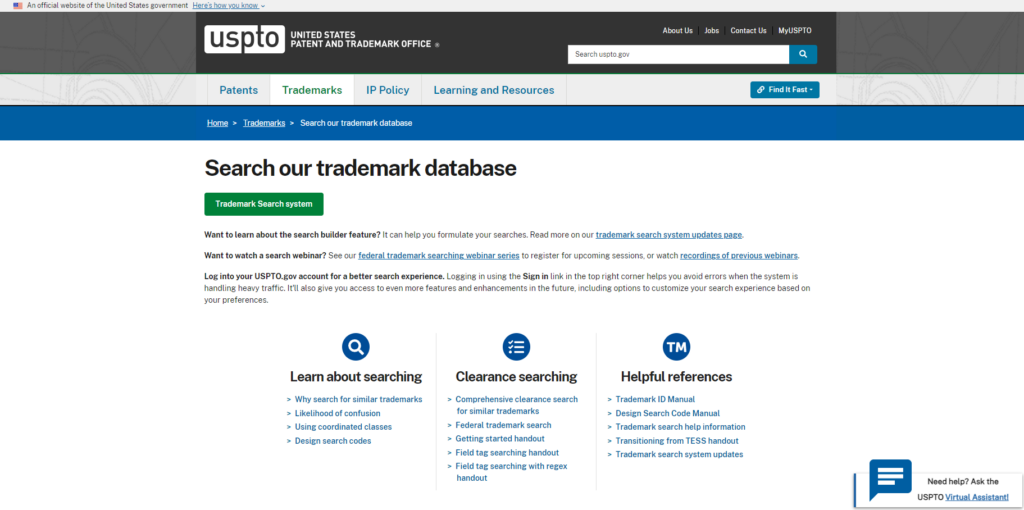
The last thing you want is to invest time and money in a brand name only to discover later that you can’t use it due to a conflict.
How to Conduct a Trademark Search:
- Use the USPTO’s Trademark Electronic Search System (TESS): This free online database allows you to search for registered and pending trademarks. Be sure to search for similar spellings, variations, and phonetic equivalents of your chosen name.
- Search Beyond TESS: While TESS is a great starting point, it’s also important to search other databases, such as state trademark registries and domain name registries.
- Consider Professional Help: If you need help with conducting a comprehensive search, consider hiring a trademark attorney. They can help you identify potential conflicts and assess the risks associated with your chosen name.
A thorough search can uncover potential roadblocks early on, saving you from investing in a brand name that could lead to legal trouble down the road. Remember, nearly 20% of trademark applications are initially refused due to conflicts with existing marks. Don’t become part of that statistic!
Pro Tip: If your search reveals similar trademarks, don’t despair. A trademark attorney can help you assess the likelihood of confusion and explore options for coexisting in the marketplace.
Step 2: Preparing Your Trademark Application
Now that you’ve confirmed your name is available, it’s time to roll up your sleeves and prepare your trademark application. This involves several crucial steps to ensure a smooth and successful filing.
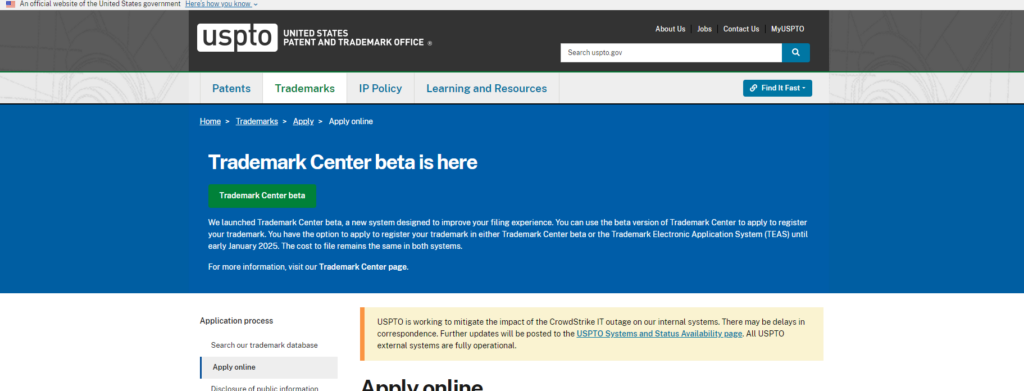
Choosing Your Filing Basis: Use in Commerce vs. Intent to Use
The USPTO offers two filing bases for trademark applications:
- Use in Commerce: This is the most common filing basis. It means you’re already using the mark in commerce, meaning it’s actively associated with your goods or services in the marketplace. To file under this basis, you’ll need to provide evidence of use, such as product labels, packaging, website screenshots, or marketing materials.
- Intent to Use: This basis is for those who have yet to use the mark in commerce but have a bona fide intention to do so. If you file under this basis, you’ll need to submit a Statement of Use later, proving that you’ve started using the mark in commerce within a specific timeframe.
Which Basis is Right for You?
- If your product or service is already available and using the trademark, use in commerce is the way to go.
- If you’re still in the planning stages and have yet to launch, intent to use is the appropriate choice.
Choosing the correct filing basis is crucial, as it affects the timing and requirements of your application.
Example:
Let’s say you’re launching a new line of handmade soaps called “Lather Up.” If you’ve already started selling these soaps online or at a local market, you would file on a “use in commerce” basis. However, if you’re still developing the soaps and haven’t made any sales yet, you would file on an “intent to use” basis.
Identifying Your Goods/Services: Getting Specific
Trademark protection isn’t a blanket over everything your business does. It’s specific to the goods and services you offer. In your application, you’ll need to identify these precisely using the USPTO’s Trademark ID Manual.
This manual categorizes goods and services into 45 different classes. For example, clothing falls under Class 25, while software falls under Class 9. You’ll need to select the classes that most accurately describe your offerings.
Choosing the right classes is crucial because your trademark protection will only extend to the goods or services listed in your application. If you later expand into a different class, you’ll need to file a new application.
Tips for Identifying Your Goods/Services:
- Be Specific: Don’t just list “clothing.” Specify the types of clothing you sell (e.g., t-shirts, hats, jackets).
- Don’t Overreach: Only include the goods/services you actually offer or have a bona fide intent to offer soon.
- Use the Correct Wording: The USPTO has specific wording requirements for each class. Use the ID Manual to ensure you’re using the appropriate terminology.
Example:
If your business sells custom-designed t-shirts and coffee mugs, you likely select Class 25 (Clothing, footwear, headgear) and Class 21 (Household or kitchen utensils and containers).
Gathering Evidence of Use: Proving Your Mark is in Action
If you’re filing on a “use in commerce” basis, you’ll need to provide evidence that you’re actively using your trademark in the marketplace. This evidence is called a “specimen.”
A specimen is a real-world example of how you’re using the mark to identify your goods or services. It could be:
- Product labels or tags: A photograph of your product with the trademark clearly visible.
- Packaging: A photograph of the packaging your product comes in featuring the trademark.
- Website screenshots: Images of your website showing the trademark prominently displayed.
- Marketing materials: Brochures, advertisements, or social media posts that use the trademark.
The key is to show that the trademark is being used to distinguish your goods/services from those of others. The specimen should also match the description of goods/services you provided in your application.
Elementor Showcase: How Businesses Utilize Elementor for Branding
Elementor, a popular website builder, can be a powerful tool for creating a strong brand identity that can be used as evidence of use in your trademark application. With Elementor, you can easily design visually appealing websites, landing pages, and marketing materials that showcase your trademark prominently.

Examples of How Elementor Can Help:
- Logo Integration: Seamlessly incorporate your logo into your website’s header, footer, or other key areas.
- Consistent Branding: Use Elementor’s global design features to ensure consistent use of your brand colors, fonts, and styles across your website.
- Customizable Templates: Choose from a wide range of templates and customize them to match your brand identity.
- Social Media Integration: Easily share your branded content on social media platforms to establish your mark in the marketplace further.
By leveraging Elementor’s design capabilities, you can create a cohesive brand presence that strengthens your trademark application and sets you apart from the competition.
Step 3: Filing Your Application: The TEAS System
With your trademark search complete and your application materials ready, it’s time to dive into the official filing process. The USPTO’s Trademark Electronic Application System (TEAS) is your gateway to trademark registration.
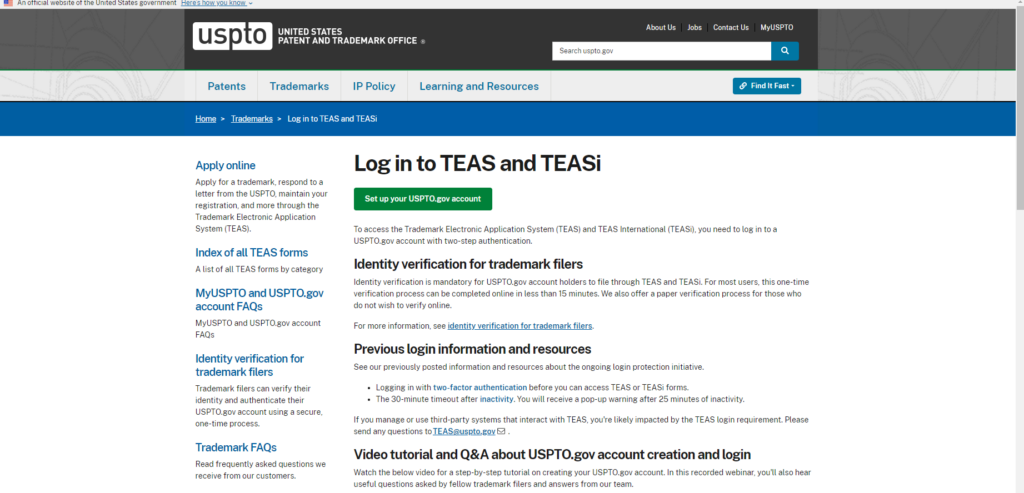
TEAS vs. TEAS Plus: Choosing the Right Path
The USPTO offers two options for filing your trademark application through TEAS:
- TEAS Plus: This streamlined option is designed for straightforward applications where you can confidently answer all the required questions and meet specific criteria. TEAS Plus offers a lower filing fee and a more efficient review process.
- TEAS Standard: This option provides more flexibility for complex applications or situations where additional guidance might be needed. While the filing fee is higher, TEAS Standard allows for more back-and-forth communication with the USPTO during the examination process.
Which Option Should You Choose?
- If your application is relatively simple and you meet the TEAS Plus requirements, it’s the most cost-effective and efficient choice.
- If your application is more complex or you anticipate needing more flexibility during the review process, TEAS Standard might be a better fit.
Choosing the right option can save you time and money, so carefully consider your needs before making a decision.
Step-by-Step TEAS Walkthrough: Navigating the Application
Now that you’ve chosen the appropriate TEAS option let’s walk through the application process step-by-step.
- Create a USPTO.gov Account: If you don’t already have one, you’ll need to create one on the USPTO website. This account will allow you to access TEAS and manage your trademark applications.
- Select Your Application Type: Depending on your needs and the complexity of your application, choose either TEAS Plus or TEAS Standard.
- Enter Applicant Information: Provide your name, address, and contact information. If you’re filing on behalf of a business, you’ll need to provide the business information as well.
- Mark Information: Enter your trademark (word, phrase, logo, or combination) and select the appropriate class(es) of goods/services from the ID Manual.
- Filing Basis: Indicate whether you’re filing under “use in commerce” or “intent to use.”
- Specimen(s): If filing under “use in commerce,” upload your specimen(s) as evidence of use.
- Drawing: If your trademark includes a design element, you’ll need to upload a drawing of your mark in a specific format.
- Disclaimer: If your mark includes a descriptive term, you may need to disclaim that portion of the mark.
- Signature: Electronically sign the declaration, certifying that the information in your application is accurate.
- Payment: Pay the required filing fee online.
Navigating the TEAS System
While the TEAS system is designed to be user-friendly, it can still feel overwhelming for first-time filers. Here are some tips for navigating the process:
- Read the Instructions Carefully: The USPTO provides detailed instructions for each section of the application. Take the time to read them thoroughly before proceeding.
- Save Your Progress Regularly: TEAS allows you to save your application as you go. This is helpful in case you need to take a break or gather additional information.
- Double-Check Your Information: Before submitting your application, review all the information carefully to ensure accuracy. Errors can cause delays or even rejections.
- Seek Help if Needed: If you have questions or encounter difficulties, the USPTO offers assistance through its Trademark Assistance Center.
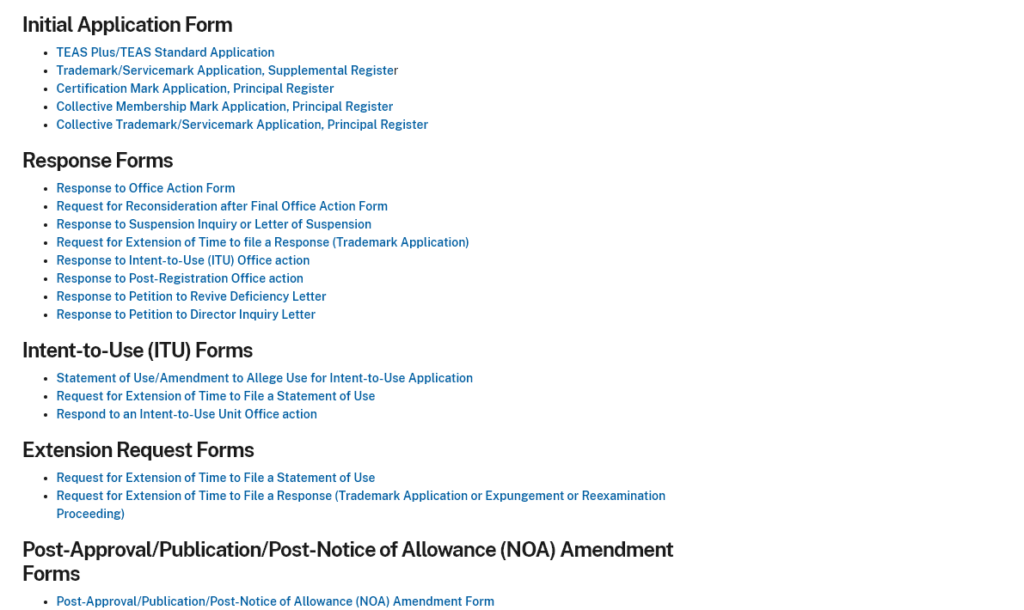
Common Mistakes to Avoid: Smooth Sailing Through TEAS
Even with a user-friendly system like TEAS, mistakes can happen. Here are some common pitfalls to avoid:
- Incorrect Classification: Double-check the ID Manual to ensure you’ve selected the correct classes for your goods/services.
- Insufficient Specimen: If filing under “use in commerce,” make sure your specimen clearly shows your mark being used in a way that matches your application.
- Incomplete Information: Fill out all required fields in the application and provide accurate contact information.
- Missing Deadlines: Be aware of deadlines for responding to office actions and filing Statements of Use (if applicable).
- Not Proofreading: Carefully review your application before submitting it to catch any typos or errors.
By being mindful of these common mistakes, you can increase your chances of a smooth and successful trademark application process.
Step 4: The Examination Process
Congratulations! You’ve successfully submitted your trademark application. Now, the USPTO takes over the examination process. This is where your application is reviewed to ensure it meets all the legal requirements for registration.
The Role of the Trademark Examiner
Your application will be assigned to a trademark examiner, an attorney who works for the USPTO. The examiner’s job is to scrutinize your application and determine whether your mark is eligible for registration. They’ll review you:
- Trademark: They’ll assess whether your mark is distinctive enough and not confusingly similar to any existing trademarks.
- Goods/Services: They’ll check if you’ve accurately classified your goods/services and if your mark is appropriate for those categories.
- Specimen(s): If you’ve filed under “use in commerce,” they’ll examine your specimens to ensure they meet the requirements.
- Application: They’ll look for any errors or inconsistencies in your application.
The examiner may conduct additional research, such as searching for similar marks in other databases or reviewing relevant case law. This process can take several months, so patience is key.
Office Actions: Don’t Panic, Just Respond
If the examiner finds any issues with your application, they’ll issue an “office action.” This is a letter that outlines the problems and gives you a chance to respond. Common reasons for office actions include:
- Likelihood of Confusion: Your mark is too similar to an existing trademark.
- Descriptiveness: Your mark is merely descriptive of your goods or services and lacks distinctiveness.
- Improper Specimen: Your specimen needs to show the use of the mark in commerce adequately.
- Incorrect Classification: You’ve classified your goods/services in the wrong class.
Receiving an office action isn’t the end of the road. It’s simply an opportunity to address the issues and provide additional information or arguments to support your application.
How to Respond to an Office Action:
- Carefully Review the Office Action: Understand the specific issues raised by the examiner.
- Consult an Attorney (Optional): If the issues are complex or you need help with how to proceed, consider seeking legal advice.
- Prepare a Response: Address each issue raised in the office action with evidence and legal arguments.
- Submit Your Response: File your response with the USPTO within the specified deadline (usually six months).
Remember, responding to an office action is a crucial step in the trademark registration process. A well-crafted response can overcome objections and lead to the approval of your application.
Step 5: Publication & Opposition
If your application clears the examination process, it enters the publication phase. This is a crucial step that opens the door for potential opposition from third parties.
Official Gazette: Your Mark Goes Public
After approval, your trademark is published in the USPTO’s Official Gazette, an online publication of pending and registered trademarks. This publication serves two primary purposes:
- Public Notice allows the public to review your trademark and determine whether it conflicts with their own marks.
- Opposition Period: Anyone who believes your trademark will harm their interests has a 30-day window to file a Notice of Opposition.
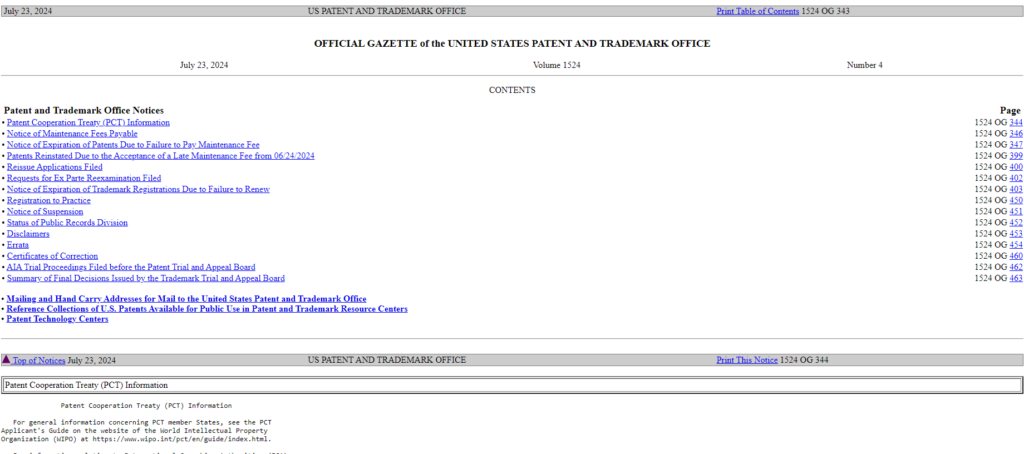
The Official Gazette is published weekly, and your mark will typically appear within a few weeks of approval. Once published, you can use the “TM” symbol next to your mark to indicate it’s pending registration.
Opposition Period: Defending Your Claim
The opposition period is a nerve-wracking time for trademark applicants. During these 30 days, anyone who believes your trademark will harm their business or interests can file a Notice of Opposition with the Trademark Trial and Appeal Board (TTAB).
Who Might Oppose?
- Owners of similar trademarks
- Competitors in your industry
- Anyone who feels your mark is too close to their own or could confuse the marketplace.
What Happens if Someone Opposes?
If an opposition is filed, the case goes before the TTAB, an administrative court that handles trademark disputes. You’ll need to present evidence and legal arguments to defend your trademark. This process can be time-consuming and expensive, often requiring the assistance of a trademark attorney.
Proactive Measures:
While opposition isn’t common (it occurs in about 3% of cases), it’s wise to be prepared. You can proactively search the Official Gazette during the publication period to see if any similar marks are published. If you find any, consult with an attorney to assess the risk of opposition and develop a strategy.
Step 6: Registration & Maintenance
If no one opposes your trademark during the publication period, or if you successfully overcome any opposition, you’re on the home stretch!
Receiving Your Registration Certificate: The Golden Ticket
Congratulations! Your trademark application has been approved, and you’ll receive an official registration certificate from the USPTO. This certificate is proof of your ownership of the trademark and grants you the exclusive right to use the mark in connection with your goods or services.
What to Do with Your Certificate:
- Use the Registered Trademark Symbol: To indicate your trademark’s registered status, start using the ® symbol next to it.
- Keep Records: Maintain a copy of your certificate in a safe place for future reference.
- Monitor Your Mark: Regularly check the marketplace for any unauthorized use of your trademark.
Renewal Deadlines: Protecting Your Investment
Trademark registration is more than just a one-and-done deal. To maintain your trademark rights, you’ll need to file renewal applications and declarations of use periodically.
- First Renewal: Between the fifth and sixth year after registration.
- Subsequent Renewals: Every ten years after registration.
Declarations of Use:
In addition to renewals, you’ll also need to file declarations of use to show that you’re still actively using the trademark in commerce. These are typically due between the fifth and sixth year after registration then every ten years after that.
Please file renewals or declarations of use to avoid the cancellation of your trademark registration. So, mark your calendar and stay on top of these deadlines to ensure your brand remains protected.
Step 7: Protecting Your Trademark
Your trademark is officially registered – congratulations! But the work doesn’t stop here. Protecting your trademark is an ongoing process that requires vigilance and proactive measures.
Monitoring for Infringement: Staying Vigilant
Trademark infringement occurs when someone uses your mark (or a confusingly similar one) without your permission in a way that’s likely to cause consumer confusion. To protect your brand’s integrity and value, it’s essential to monitor the marketplace for potential infringers.
How to Monitor Your Trademark:
- Google Alerts: Set up alerts for your trademark and any variations of it. This will notify you when your mark is mentioned online, allowing you to identify potential infringement quickly.
- Social Media Monitoring: Regularly search social media platforms for unauthorized use of your mark.
- Industry Publications: Look for mentions of your brand or competitors using similar marks in trade publications and industry news.
- Hire a Monitoring Service: Several companies specialize in trademark monitoring and can alert you to potential infringement.
Early Detection is Key:
The sooner you detect infringement, the easier it is to address it. Ignoring infringement can weaken your trademark rights and make it more difficult to enforce them in the future.
Enforcement Options: Taking Action Against Infringers
If you discover someone infringing on your trademark, you have several options for enforcement:
- Cease and Desist Letter: This formal letter demands that the infringer stop using your mark. It’s often the first step in resolving infringement disputes.
- Negotiation: You can negotiate a resolution with the infringer, such as a licensing agreement or a change to their mark.
- Litigation: If negotiations fail, you can file a lawsuit against the infringer in federal court. This can be a lengthy and costly process, but it may be necessary to protect your brand.
The specific enforcement strategy you choose will depend on the severity of the infringement, the infringer’s willingness to cooperate, and your overall business goals.
Licensing and Assignments: Sharing (or Selling) Your Mark
Trademark rights are valuable assets, and you might consider sharing or transferring them under certain circumstances.
- Licensing involves granting permission to another party to use your trademark on their goods or services in exchange for a fee or royalty. Licensing can expand your brand’s reach and generate additional revenue.
- Assignment: This involves permanently transferring ownership of your trademark to another party. This might happen if you sell your business or a product line.
Key Considerations:
Before licensing or assigning your trademark, it’s crucial to have a written agreement in place that clearly outlines the terms of use, payment, quality control, and other relevant details. This helps protect your brand’s reputation and ensures that your mark is being used appropriately.
DIY vs. Hiring an Attorney: Making the Right Choice
One of the most common questions people have when considering trademarking is whether to go it alone or hire an attorney. This decision depends on several factors, including your budget, the complexity of your application, and your comfort level with legal matters.
Pros and Cons of DIY:
Pros:
- Cost Savings: Filing a trademark application yourself can save you money on legal fees.
- Empowerment: Taking ownership of the process can be a rewarding experience.
- Learning Opportunity: You’ll gain valuable knowledge about trademark law and the USPTO.
Cons:
- Time Commitment: The DIY process can be time-consuming, especially if you’re unfamiliar with the procedures.
- Risk of Errors: Mistakes in your application can lead to delays or even rejections.
- Limited Expertise: You may not be equipped to handle complex legal issues or opposition proceedings.
Finding the Right Trademark Attorney
If you decide to hire an attorney, choose one with experience in trademark law and a good understanding of your industry. They can:
- Conduct a Comprehensive Search: Ensure your mark is available and advise you on potential risks.
- Prepare and File Your Application: Handle all the paperwork and ensure your application is complete and accurate.
- Respond to Office Actions: Craft persuasive arguments to overcome any objections raised by the examiner.
- Represent You in Opposition Proceedings: Defend your trademark if a third party challenges it.
- Provide Ongoing Counsel: Advise you on maintaining and enforcing your trademark rights.
Cost: Trademark attorney fees can vary widely depending on their experience, location, and the complexity of your case. It’s best to get quotes from several attorneys before making a decision.
Conclusion
Trademarking your name might seem like a daunting task, but with the right knowledge and resources, it’s entirely achievable. By following the seven steps outlined in this guide, you can protect your brand identity, secure your intellectual property, and position yourself for long-term success.
Remember, a trademark is more than just a name or a logo; it embodies your brand’s reputation and value. Whether you tackle the trademark process yourself or seek professional guidance, taking the necessary steps to protect your brand is an investment in your business’s future.
Don’t let fear or uncertainty hold you back. Take action today and secure your brand’s legacy for years to come.
Frequently Asked Questions
Trademarking can be a complex process, and it’s natural to have questions along the way. Here are some of the most frequently asked questions about trademarking in the US:
How much does it cost to trademark a name?
The cost of trademarking a name can vary depending on several factors, including the filing basis, the number of classes of goods/services you’re applying for, and whether you hire an attorney. The basic filing fee for a TEAS Plus application is $250 per class, while a TEAS Standard application costs $350 per class. If you hire an attorney, their fees will be additional.
How long does it take to trademark a name?
The trademark registration process typically takes 8-12 months from the date of filing. However, it can take longer if complications arise, such as office actions or opposition proceedings.
Can I trademark a name that’s already in use?
It depends. If someone else is already using the same or a similar mark for the same or similar goods/services, you may not be able to register it. However, if the other use is in a different geographic area or for different goods/services, it could coexist.
Do I need a lawyer to trademark a name?
While it’s not required to hire an attorney, it’s highly recommended, especially if your application is complex or you anticipate potential issues. An experienced trademark attorney can guide you through the process, increase your chances of success, and protect your interests.
Can I trademark a name myself?
Yes, you can file a trademark application yourself using the USPTO’s TEAS system. However, it’s important to understand the process and requirements thoroughly to avoid costly mistakes.
What happens if someone infringes on my trademark?
If someone uses your trademark without permission, you can take legal action to stop them. This could involve sending a cease and desist letter, negotiating a settlement, or filing a lawsuit.
Looking for fresh content?
By entering your email, you agree to receive Elementor emails, including marketing emails,
and agree to our Terms & Conditions and Privacy Policy.






